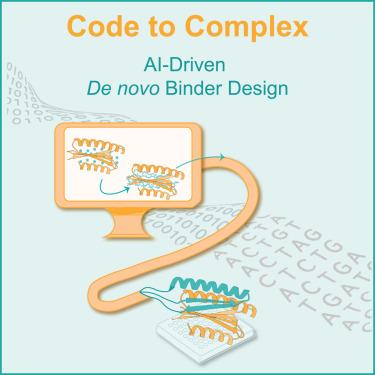代码复杂:人工智能驱动的从头设计
IF 4.3
2区 生物学
Q2 BIOCHEMISTRY & MOLECULAR BIOLOGY
引用次数: 0
摘要
人工智能在结构生物学中的应用已经将蛋白质设计从概念上的挑战转变为创造新自然蛋白质的实用方法。通过利用机器学习,研究人员现在可以通过计算设计具有定制结构和结合特异性的蛋白质。这使得高亲和力的结合物能够快速地在硅中产生,以达到不同的和以前难以处理的目标。与传统的实验方法相比,这种方法大大减少了粘合剂的开发时间和资源需求,同时提高了命中率和可设计性。最近的成功包括创造结合蛋白来中和毒素,调节免疫途径,并以高亲和力和特异性参与无序靶标。模型准确性的提高扩大了可以设计的范围,而临床前模型的表征为治疗发展铺平了道路。从头开始的粘合剂设计代表了蛋白质工程的范式转变,现在可以对定制粘合剂进行编程,以满足特定的生物挑战。本文章由计算机程序翻译,如有差异,请以英文原文为准。

Code to complex: AI-driven de novo binder design
The application of artificial intelligence to structural biology has transformed protein design from a conceptual challenge into a practical approach for creating new-to-nature proteins. By leveraging machine learning, researchers can now computationally design proteins with tailored architectures and binding specificities. This has enabled the rapid in silico generation of high-affinity binders to diverse and previously intractable targets. This approach dramatically reduces binder development time and resource requirements, compared to traditional experimental approaches, while improving hit rates and designability. Recent successes include the creation of binding proteins that neutralize toxins, modulate immune pathways, and engage disordered targets with high affinity and specificity. Improvements in model accuracy are expanding the scope of what can be designed, while characterization in preclinical models is paving the way for therapeutic development. De novo binder design represents a paradigm shift in protein engineering, where custom binders can now be programmed to meet specific biological challenges.
求助全文
通过发布文献求助,成功后即可免费获取论文全文。
去求助
来源期刊

Structure
生物-生化与分子生物学
CiteScore
8.90
自引率
1.80%
发文量
155
审稿时长
3-8 weeks
期刊介绍:
Structure aims to publish papers of exceptional interest in the field of structural biology. The journal strives to be essential reading for structural biologists, as well as biologists and biochemists that are interested in macromolecular structure and function. Structure strongly encourages the submission of manuscripts that present structural and molecular insights into biological function and mechanism. Other reports that address fundamental questions in structural biology, such as structure-based examinations of protein evolution, folding, and/or design, will also be considered. We will consider the application of any method, experimental or computational, at high or low resolution, to conduct structural investigations, as long as the method is appropriate for the biological, functional, and mechanistic question(s) being addressed. Likewise, reports describing single-molecule analysis of biological mechanisms are welcome.
In general, the editors encourage submission of experimental structural studies that are enriched by an analysis of structure-activity relationships and will not consider studies that solely report structural information unless the structure or analysis is of exceptional and broad interest. Studies reporting only homology models, de novo models, or molecular dynamics simulations are also discouraged unless the models are informed by or validated by novel experimental data; rationalization of a large body of existing experimental evidence and making testable predictions based on a model or simulation is often not considered sufficient.
 求助内容:
求助内容: 应助结果提醒方式:
应助结果提醒方式:


